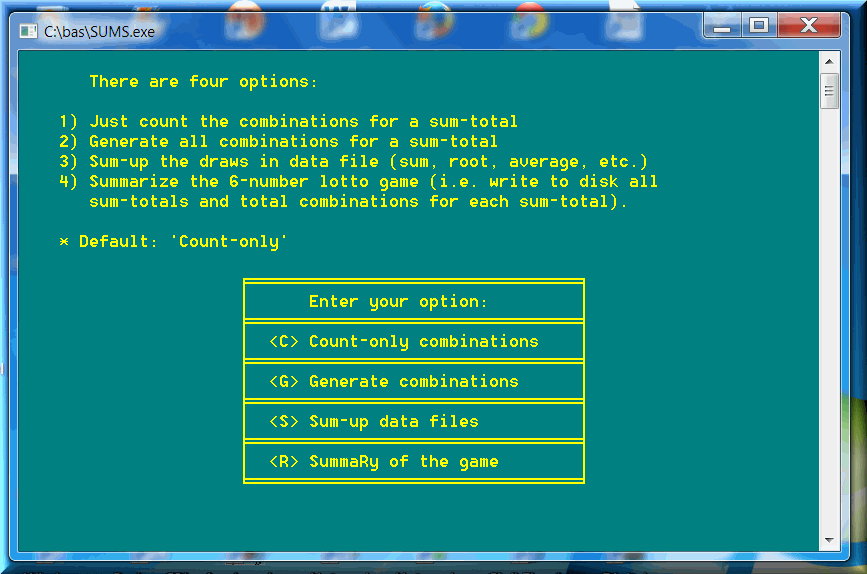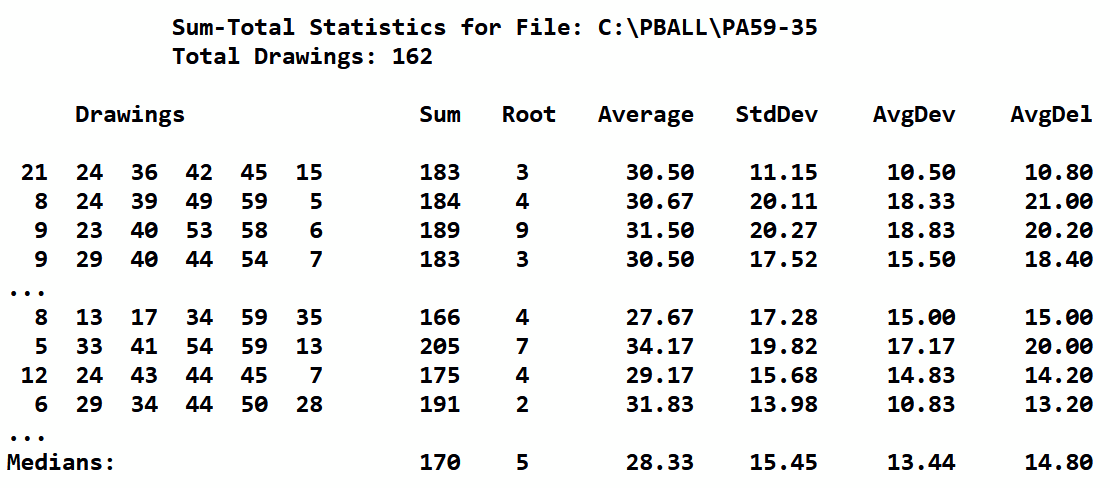
Lottery Sums, Root Sum — Pick Daily, Pick 5 (formerly Quinto), Lotto 5, 6, Powerball, Mega Millions, Euromillions
★ ★ ★ ★ ★
By Ion Saliu, Founder of Lottery Mathematics



First captured by the WayBack Machine (web.archive.org) on October 23, 2007.
A lot of lottery players have a keen interest in a topic such as the title of this document: sums of lottery games. Furthermore, if you land in lottery communities (forums, newsgroups, blogs), you will come across quite a few requests to show charts of sum-totals or sums of various lotto and lottery games.
The surprise for you and me has to do with this scarcity: There is only one piece of software that accurately creates such statistical charts! Just one lottery program, fittingly named Sums. Yes, it's me who wrote it! But I am not writing this to brag about that piece of incredulously great lotto software – or am I? NOT!
Sums has always plotted charts for the sums in just about any kind of lottery and lotto games (since 1990s). And, for sure, no other program has ever done it. They lie when they claim they created the lottery some charts in Excel spreadsheets. A spreadsheet cannot handle millions and millions of lotto combinations, especially games like Powerball and Mega Millions. I've seen code by others to only generate lotto combinations for one sum-total at a time, not for an entire game in one run.
This piece of special software does a whole lot more mathematically than just plotting sum tables. For starters, the application generates all the combinations for a given sum-total. You can't do that in an Excel spreadsheet. Moreover, the Sums lottery software performs comprehensive statistical analyses of lottery data (results) files. The statistics of a lotto data file show the sums, and then sum... I mean some... mean averages, medians, standard deviation, average deviations, deltas...
This lottery program came to life by request from... a school student! A computer science teacher gave the class a programming assignment:

Deltas, anyone? Well, that sounds like a fancy word. It is for the alphabet letter D of the Classical Greek language (the one that educated humans in creating the Modern Civilization). D is the mnemonic for difference. Lottery deltas are differences between adjacent lottery numbers. For example, delta_1 represents the difference between the number one and the 2nd number in a lotto combination. The delta is expressed as an absolute number, not a signed number. Lotto number_1 = 1; lotto number_2 = 7; delta = 7 – 1 = 6 (it is never minus 6).
Let us show here for everybody to see and use — for their personal usage only — never for commercial use! (Other sites will never tell you what lottery software they are using to plot the charts of any possible lotto game... for such software has been mine-only in the 20th and 21st centuries!)
Following are links to sum-total, root sums charts for a wide variety of lottery and lotto games all over the world. Each game has its own Web page for the best possible viewing. The sum-total/root sums charts show the percentages as well. The percentages are directly related to the theoretical lottery probabilities.
The screenshot below shows an analysis of a data (drawings) file for the Powerball, Mega Millions lotto game.


Axiomatic one, the statistical parameters of the bottom line (Medians) are virtually identical to what mathematics calculates for the respective parameters. By the way - StdDev means standard deviation, while Del refers to lotto deltas - or the absolute difference between two neighboring numbers. The statistical parameters for the most common lotto game (6/49) are mathematically equivalent (the real data is for the Pennsylvania Lottery Match 6, 864 drawings analyzed):

Well, indelibly axiomatic colleague of mine, look no further than the bottom line. The (in)famous combonation above has a sum of 21; mathematically and practically, that sum-total should be close to 150 (anyway, not that far away as sum 21 is). The average delta of 1 2 3 4 5 6 is a mere 1; mathematically and practically, that delta average should be close to 7.40. The average is a very low 3.5. The standard deviation is the most convincing tell-tale fact: 1.71. It is 7.5 times lower than the norm of 12.90!
As we can see now, a combination like 1 2 3 4 5 6 is statistically very far away from the mathematical norms.

Resources in Lottery Software, Lotto Wheeling, Lottery Sums

Home | Search | Help | New Writings | Software | Odds, Generator | Contents | Forums | Sitemap
